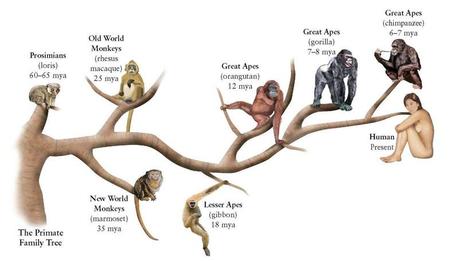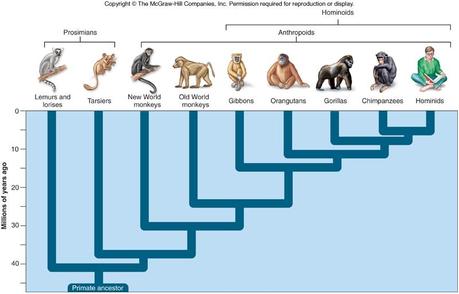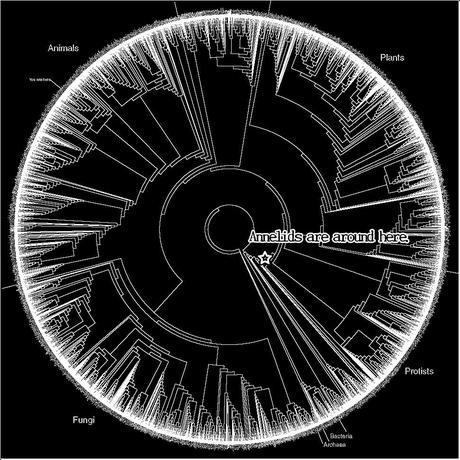When we account for human history in evolutionist or developmental terms, we nearly always fall into the trap of teleology and progressivism. Even when evolutionist schemes are carefully and empathetically rendered (I’m thinking here of Robert Bellah), the unstated implication is that some groups have developed more complex ideas than others. While this may be true in some domains (i.e., knowledge related to materials, technology, and science), it is not true of other domains (i.e., worldviews, cosmologies, and religion).
The problem with cultural evolutionary or historical developmental schemes is that they continue to be rendered gradistically rather than cladistically. Decades ago, most evolutionary scientists abandoned (teleological and progressive) gradistic classification, with its subjective weighing of characters or traits deemed to be “primitive” or “advanced,” and moved to cladistic classification which recognizes that all existing forms are equally evolved, with some being more derived than others.
Here, for example, is a gradistic representation of primate evolution:

The message being sent is clear: humans are the most evolved primates, with all other primates being “primitive” forms that stopped evolving at various junctures millions of years ago. When viewed this way, primate evolution appears to be matter of developmental trending towards humans. This is gradistic, progressive, teleological, and wrong.
Here, by way of contrast, is a cladistic representation of primate evolution:

The message of this diagram is quite different: all extant primates are equally evolved. There are no progressive trends and none are more “primitive” or “advanced” than others. Some groups may be more derived than others, but existing adaptive diversity is not graded, valued, or judged. This is the correct view.
If the same thing were done when it comes to human history and culture, we would recognize that hunter-gatherers are not developmentally arrested and have not failed to develop or advance along with the majority of (agricultural and industrial) humanity. In fact, the majority of recently extant hunter-gatherers represent groups who rejected agriculture, and either retreated from it or fought against it in an effort to preserve a preferred way of life. These were deliberate and considered choices.
In a recent critique of Jared Diamond, Wade Davis took issue with the ideas of progress, development, trending, and advance which are implicit in Diamond’s work:
There is no hierarchy of progress in the history of culture, no Social Darwinian ladder to success. The Victorian notion of the savage and the civilised, with European industrial society sitting proudly at the apex of a pyramid of advancement that widens at the base to the so-called primitives of the world, has been thoroughly discredited….
The other peoples of the world are not failed attempts at modernity, let alone failed attempts to be us. They are unique expressions of the human imagination and heart, unique answers to a fundamental question: what does it mean to be human and alive? When asked this question, the cultures of the world respond in 7000 different voices, and these answers collectively comprise our human repertoire for dealing with all the challenges that will confront us as a species as we continue this never-ending journey….
The very premise of Guns, Germs and Steel is that a hierarchy of progress exists in the realm of culture, with measures of success that are exclusively material and technological; the fascinating intellectual challenge is to determine just why the west ended up on top. In the posing of this question, Diamond evokes 19th-century thinking that modern anthropology fundamentally rejects. The triumph of secular materialism may be the conceit of modernity, but it does very little to unveil the essence of culture or to account for its diversity and complexity.
Consider Diamond’s discussion of the Australian Aborigines in Guns, Germs and Steel. In accounting for their simple material culture, their failure to develop writing or agriculture, he laudably rejects notions of race, noting that there is no correlation between intelligence and technological prowess. Yet in seeking ecological and climatic explanations for the development of their way of life, he is as certain of their essential primitiveness as were the early European settlers who remained unconvinced that Aborigines were human beings. The thought that the hundreds of distinct tribes of Australia might simply represent different ways of being, embodying the consequences of unique sets of intellectual and spiritual choices, does not seem to have occurred to him.
In truth, as the anthropologist WEH Stanner long appreciated, the visionary realm of the Aborigines represents one of the great experiments in human thought. In place of technological wizardry, they invented a matrix of connectivity, an intricate web of social relations based on more than 100 named kin relationships. If they failed to embrace European notions of progress, it was not because they were savages, as the settlers assumed, but rather because in their intellectual universe, distilled in a devotional philosophy known as the Dreaming, there was no notion of linear progression whatsoever, no idealisation of the possibility or promise of change. There was no concept of past, present, or future. In not one of the hundreds of Aboriginal dialects and languages was there a word for time.
The entire purpose of humanity was not to improve anything; it was to engage in the ritual and ceremonial activities deemed to be essential for the maintenance of the world precisely as it was at the moment of creation. Imagine if all of Western intellectual and scientific passion had focused from the beginning of time on keeping the Garden of Eden precisely as it was when Adam and Eve had their fateful conversation.
Clearly, had our species as a whole followed the ways of the Aborigines, we would not have put a man on the moon. But, on the other hand, had the Dreaming become a universal devotion, we would not be contemplating today the consequences of climate change and industrial processes that threaten the life supports of the planet….
Traditional societies…remind us that our way is not the only way. A child raised in the Andes to believe that a mountain is a protective deity will have a relationship with the natural world profoundly different from that of a youth brought up in America to believe a mountain is an inert mass of rock ready to be mined. The mythology of the Barasana and Makuna people is in every way a land management plan revealing how human beings once thrived in the Amazon rain forest in their millions. Take all the genius that enabled us to put a man on the moon and apply it to an understanding of the ocean, and what you get is Polynesia. Tibetan Buddhism condenses 2,500 years of direct empirical observation as to the nature of mind. A lama once remarked that Tibetans do not believe that Americans went to the moon, but they did. Americans may not believe, he added, that Tibetans can achieve enlightenment in one lifetime, but they do.
The voices of traditional societies ultimately matter because they can still remind us that there are indeed alternatives, other ways of orienting human beings in social, spiritual and ecological space.
While I don’t agree with all that Wade says in this essay (which I encourage you to read in full), his conception of human history and cultural diversity is correctly cladistic rather than normatively gradistic. We can be evolutionists without being progressivists. So no more evolutionary trees or progressions. Everything (including human cultures) are part of an equally evolved ball. This is the circle of currently existing life (humans are a single point in this ball, indicated just below the “Animals” notation):


